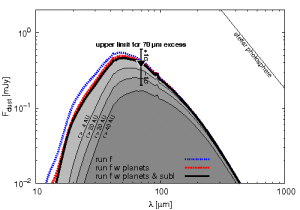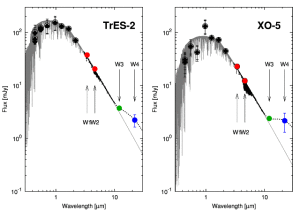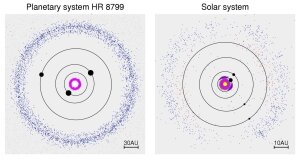Project archive
This page lists projects completed until 2015. More recent projects can be found hereExterner Link.
-
Herschel's "Cold Debris Disks"
Mehr erfahrenIt is a natural desire of astronomers to find planetary systems similar to the Solar System in which we live - but instead, they often see something very different, and totally unexpected. ESA's Herschel space observatory has now found six Sun-like stars that are surrounded by mysterious cold dusty belts, different from everything known previously.
-
An Improved Model of the Edgeworth-Kuiper Debris Disk
Mehr erfahrenSpectral energy distribution of the EKB including planets and sublimation.
Grafik: Vitense et al. 2012We accessed the expected EKB dust disk properties by modeling. We treated the debiased population of the known trans-Neptunian objects (TNOs) as parent bodies and generated the dust with our collisional code. The resulting dust distributions were modified to take into account the influence of gravitational scattering and resonance trapping by planets on migrating dust grains as well as the effect of sublimation.
-
Debris disk candidates in systems with transiting planets
Mehr erfahrenSpectral energy distributions of the two systems
Grafik: Krivov et al. 2011Debris disks are known to exist around many planet-host stars, but no debris dust has been found so far in systems with planets discovered by the transit method. In the recently published catalog of the Wide-Field Infrared Survey Explorer (WISE) satellite...
-
Warm dust around ε Eridani
Mehr erfahrenThe nearby star epsilon Eridani hosts one known inner planet, an outer Kuiper belt analog, and an inner disk of warm dust. Spitzer/IRS measurements indicate that warm dust is present at distances as small as a few AU from the star. We tested the hypothesis that the observed warm dust is generated by collisions in the outer belt and is transported inward by Poynting-Robertson drag and strong stellar winds...
-
The Edgeworth-Kuiper debris disk
Mehr erfahrenThe Edgeworth-Kuiper debris disk is (obviously) the nearest debris disk known. Like in all other debris disks large planetesimals produce dust in mutual collisions. The big difference to extrasolar Kuiper belts is that we actually can see the planetesimals. More than 1250 objects have been discovered up to now. Of course a lot more should be there...
-
Herschel Space Observatory investigates gas and dust in forming and mature planetary systems
Mehr erfahrenKuiper Belt analog of a nearby star q1 Eridani
Grafik: Liseau et al. 2010The Herschel Space Observatory, with its 3.5 meter-sized mirror, represents the largest space-based telescope in the history. It was launched into space in May 2009 and is now conducting observations in the far-infrared, probing the coldest dusty and gaseous regions in the Universe. Herschel observations cover a diversity of objects, ranging from planets in the Solar System to distant galaxies...
-
A possible architecture of the planetary system HR 8799
Mehr erfahrenPlanetary system HR 8799 compared with the Solar system
Grafik: M. Reidemeister, AIUHR 8799 is a planetary system with several planets, planetesimal belts, and dust. We made a coherent analysis of various observational data for all known components of the system...
-
Models of debris disks: Seeing dust, thinking of planetesimals
Mehr erfahrenDebris disks are dusty disks that surround main-sequence stars. What is actually observed is the thermal emission of dust, which is produced in frequent collisions between star-orbiting planetesimals. The latter are small bodies that must have accreted at early epochs and survived possible planet formation processes. The planetesimals around a star are typically grouped in one or several belts, similar to the Kuiper belt and asteroid belt in the solar system...
-
Long term evolution of debris discs
Mehr erfahrenThe long-term evolution of a debris disc is shown to be dominated by the slow transition of the population of planetesimals from the size distribution set at their growth phase to the steady-state size distribution defined by disruptive collisions. This transition is crucial for the temporal evolution of the observable dust masses and luminosities and for the deduced total disc masses. The developed models are compatible with observational statistics from the Spitzer Space Telescope surveys...
-
Planets for β Pictoris?
Mehr erfahrenObservations have revealed a large variety of structures (global asymmetries, warps, belts, rings) and dynamical phenomena ("falling-evaporating bodies" or FEBs, the "β-Pic dust stream") in the disc of β Pictoris, most of which may indicate the presence of one or more planets orbiting the star...
-
Size and radial distributions of dust in debris discs
Mehr erfahrenThe subject of the project has been models of the size distribution and the spatial distribution of the material in so-called debris discs around main-sequence stars. Thesediscs, which are considered as remnants of the formation of planetary systems, are ensembles of objects from sub-micron-sized dust to planetesimals with diameters up to hundreds of kilometres...
-
Resonances and collisions in circumstellar debris discs induced by an embedded planet
Mehr erfahrenThis project considers theoretical models of circumstellar debris discs. The main focus is the combination of mean motion resonances between a planet and circumstellar small bodies, which create structures, and collisions among the small bodies, which smear the structures out...



